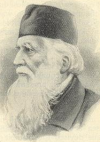
- Chess World Cup
- FIDE Grand Prix
- Olympiad
- World Championship
- List of strong tournaments
- List of world championships

- Checkmate patterns
- Chess openings
- Chess strategy
- Chess tactics
- Chess theory
- Endgames
- Pawn structure
- Problems/Compositions












 William Evans
William EvansCaptain William Davies Evans (27 January 1790 - 3 August 1872) was a seafarer and inventor, though he is best known today as a chess player. He is buried at the Belgian port of Ostend.
Evans was born at St Dogwells, Pembrokeshire, Wales. It is almost certain that young Evans went to Haverfordwest Grammar School, the only school of any antiquity in Pembrokeshire. About the beginning of the century the family moved to Castle Pill, the name of an inlet of Milford Haven on the north side, just east of Milford town. By 1818, he had learnt the moves of chess.
At the age of 14, (in 1804) Evans went out to sea to serve his country in the navy until 1815, when the war ended. He was then transferred to the postal department; by 1819, he had reached the title of Captain of the sailing packet.
Around 1825-1826, on shore leave in London, Evans played Alexander Macdonnell, beating the latter with what is now regarded in chess circles as the first creation of the Evans Gambit (1.e4 e5 2.Nf3 Nc6 3.Bc4 Bc5 4.b4).
His most famous invention was the tri-coloured lighting on naval vessels designed to prevent collisions at night. For this invention he was awarded £1500 by the British government and a gold chronometer and £200 from the Tsar of Russia.